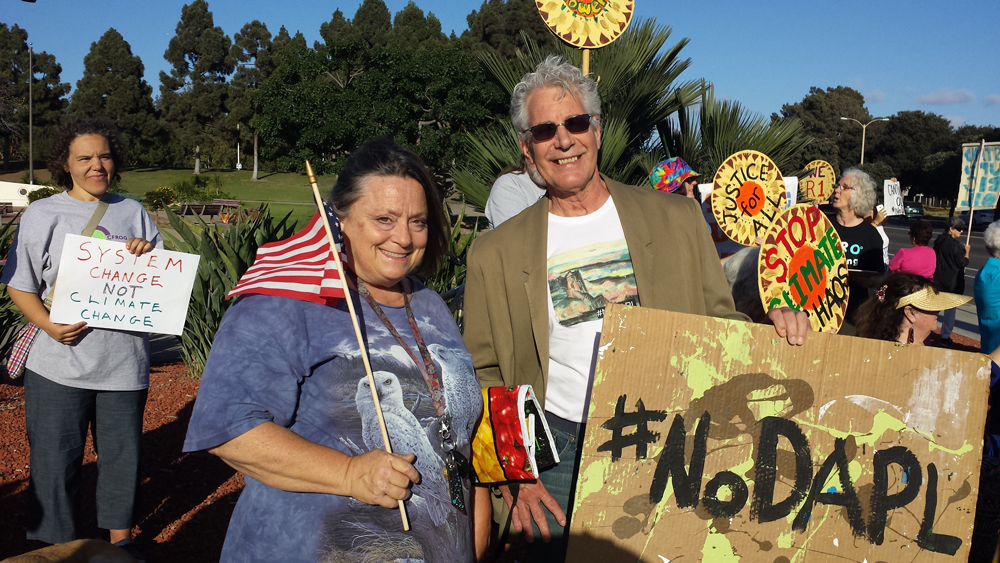June 4, 2019
RE: GPU Policy and Program Recommendations for the Land Use and Circulation, Transportation, and Mobility Elements Relating to Appendix B — Climate Change
Dear Planning Commissioners,
The 350 Ventura County Climate Hub appreciates the preliminary draft General Plan Update and Appendix B–Climate Change. Many of our suggestions and more are included and show a broad approach to climate action.
We still would like to see a sufficient expression of urgency along with metrics, goals and targets that allow progress to be tracked. Since our input last year, the United Nations now gives us 11 years to make radical transformation to avert runaway climate catastrophe. However, this Plan gives an impression of “Business as Usual”, which could lead to unimaginable climate impacts, loss of biodiversity, and human suffering, both locally and globally. Our call for a mobilization suitable to the climate emergency means setting measurable goals and targets that can be met.
In these two Elements of LU and CTM, we have the following priority interests:
LU-11.4 Sustainable Technologies
We request that this policy also apply to residential development and reference specific sustainable technologies submitted separately to you this week as follows:
- The recommended policies for electrification of buildings submitted by us on June 3 in collaboration with the Sierra Club and Earthjustice.
- The recommended policies for water conservation, wastewater management, and fire-resistant homes, including pre-approved plans for noncombustible tiny houses on permanent foundations submitted separately by Art Ludwig of Oasis Design that exemplify Sustainable Technologies.
CTM-4.1 Reduce Vehicle Miles Traveled (VMT)
We recommend priority measures to reduce VMT in two areas:
- A parking lot tax and parking pricing, in particular dividend account parking, beginning with a study and demonstration at the County Government Center, and
- A program to develop specific transportation alternatives that may include novel investments in alternative modalities that may increase economic vitality as well as energy efficiency, pollution prevention, and climate impact resilience, including shared vehicles, aerial lift, hyperloop, and self-driving cars.
Below are ten policy recommendations, three new programs and one expanded program primarily for the Circulation, Transportation and Mobility Element that relate to climate mitigation and adaptation.
Please support these recommendations to strengthen climate action in these Elements of the General Plan 2040 update.
Sincerely,
Jan Dietrick, Coordinating Team 350 Ventura County Climate Hub
Ron Whitehurst, Coordinating Team 350 Ventura County Climate Hub
Kitty Merrill, Coordinating Team, 350 Ventura County Climate Hub
Vicki Paul, Liaison to the Pacific Islands, Ventura Chapter, Citizens’ Climate Lobby
Kathleen Wheeler, Ph.D., Concerned Ventura resident
Pat Browne, RN
Elisabeth Lamar, Sierra Club Climate Committee
Michelle Nosco, Director/Founder, Arts For Earth Foundation
Adam Kaiserman, Ph.D., 350 Ventura County Climate Hub Member
Todd Shuman, Senior Analyst, WURU
Jenny Pandol, 350 Climate Hub
Wendy Lofland, Member 350 Climate Hub, Food and Water Watch, and Ventura County Coalition for Pesticide Safety
Geoffrey Dann, PE (electrical)
Ched Myers, Codirector, Bartimaeus Cooperative Ministries, Oak View
Arturo Guido, 350 VC Climate Hub and Citizens’ Climate Lobby
Carol Vesecky, Director, Biointensive for Russia
POLICY RECOMMENDATIONS
LAND USE
LU-18.5 Participation in Climate Change Planning
The County shall encourage stakeholders in designated disadvantaged communities who are vulnerable to sea level rise or other climate change impacts to have the opportunity to learn about and participate in the decision-making process for adaptation planning within Ventura County. (PI) [Source: New Policy]
COMMENTS (added words in italics):
“especially those in designated disadvantaged communities…”
RATIONALE: Make it about universal participation, not just disadvantaged communities.
CIRCULATION, TRANSPORTATION, AND MOBILITY ELEMENT
POLICIES (4 NEW AND 5 AMENDED)
CTM-2.0a Engine idling. The County shall prohibit idling of vehicle engines, other than a legally authorized emergency motor vehicle, for longer than three minutes while parking, standing or stopping, except (1) when the vehicle is forced to remain motionless because of traffic conditions or mechanical difficulties over which the operator has no control, (2) when it is necessary for the operation of safety equipment or a loading, unloading or processing device, (3) when a vehicle is being repaired, or (4) when the operator is in the process of receiving or discharging passengers on a public highway or public road. Idling a vehicle for longer than three minutes is prohibited for the purpose of warming or cooling the vehicle except to maintain a safe temperature in a bus for students with special needs. (NEW POLICY)
RATIONALE: Most jurisdictions with idling policy limit to three minutes. Such a policy may have a small reduction of air pollution and GHGs but it has a great impact by raising awareness about the need to transition away from fossil fuel transportation.
CTM –2.0b Tax Land for Parking Lots Same as for Buildings
The County shall charge a special property tax per parking space owned by businesses and offered free to employees to control demand and correct existing distortions in underpriced parking and to reduce single-occupancy trips 5 to 15 percent. (NEW PROGRAM)
CTM –2.0c Unbundled Parking
The County shall promote unbundled parking for all owners of parking lots in the County so that parking is sold or rented separately and people pay only for parking they need and avoid the hidden costs of free parking and to reduce single-passenger trips. (NEW PROGRAM)
CTM –2.0d Dividend-Account Parking System
The County shall demonstrate Dividend-Account Parking to reward employees that do not use their allotted parking space to reduce single-passenger trips by county employees by 10 to 30 percent. The County shall develop a model to encourage for other employers. (NEW PROGRAM)
CTM-2.7 Congestion Management Program
The County shall coordinate with Ventura County Transportation Commission (VCTC) to implement and update the Congestion Management Program (CMP). The County shall also encourage consideration of multimodal performance measures as part of future updates to the CMP. (MPSP, IGC) [Source: New Policy]
COMMENT (add words in italics)
“… multimodal performance and congestion and parking pricing measures as part of future updates to the CMP.” (NEW PROGRAM)
CTM-2.11 Efficient Land Use Patterns
The County shall establish land use patterns that promote shorter travel distances between residences, employment centers, and retail and service-oriented uses to support the use of public transportation, walking, bicycling, and other forms of transportation that reduce reliance on single passenger automobile trips. (RDR, MPSP) [Source: New Policy]
COMMENT (add words in italics)
“…and other forms of transportation, and study rezoning to mixed use, live-work and changes from single-family to multi-family housing to reduce reliance on single passenger automobile trips.”
CTM-2.21 Intercommunity and Countywide Public Transportation System
The County shall continue to work with Ventura County Transportation Commission (VCTC), and local public transportation regional bus service providers to promote the expansion of a safe, efficient, convenient, integrated, and cost-effective intercommunity and countywide public transportation and bus service that provides county residents with access to employment, commercial services, health and medical facilities, social service, and personal business destinations. (IGC) [Source: Existing GPP Goal 4.2.1.7, modified]
COMMENT (add words in italics)
“ …intercommunity and countywide public transportation, bus, including shared vehicles, study of aerial lift or cable car and hyperloop service that provides…”
CTM-4.1 Reduce Vehicle Miles Traveled (VMT)
The County shall work with Caltrans and Ventura County Transportation Commission (VCTC) to reduce VMT by:
-
facilitating the efficient use of existing transportation facilities;
-
striving to provide viable modal choices that make driving alone an option rather than a necessity;
-
supporting variable work schedules to reduce peak period VMT; and
-
providing more direct routes for pedestrians and bicyclists.
(MPSP, SO) [Source: Existing GPP Goal 4.2.1.6, modified]
COMMENT Replace above with the following:
The County shall implement remote work-site accommodations to reduce peak period VMT and dividend account parking programs for county employees and customers to reduce VMT. The County shall work with CalTrans and VCTC to reduce VMT by [include the above four measures above that are in the draft plan].
RATIONALE
Working remotely may include from home and also geographically distributed county employee work spaces. An automated dividend account parking system, such as has been implemented at Oceanside City Hall, rewards employees that do not use the parking space planned for them and reduces driving through the lot to find an empty space.
CTM-6.5 Electric Vehicle Charging Stations
The County shall support…(RDR, SO) [Source: New Policy]
COMMENT (REPLACE WITH THE FOLLOWING)
“The County shall require the installation of electric vehicle charging stations at County facilities, parking lots, park-and-ride lots, truck stops, and cultural and recreation destinations including county parks where feasible.”
IMPLEMENTATION PROGRAMS (3 new and 1 expanded)
CTM-NEW(1) Aerial Tramway Feasibility and Comparison to Widening SR 33
The County shall evaluate the feasibility of building an aerial tramway above the Ventura River floodplain to reduce VMT on State Route 33 from the end of the Ojai freeway at Casitas Vista Rd to the City of Ojai and to provide resilience after extreme rain events that may wash out roads and bridges.
CTM-NEW(2) Education Toward Electrifying the Transportation System Including New Modalities
The County shall conduct public and voter education about the necessity and benefits of transition to public transit and electrification of the transportation system in anticipation of new transportation modes that may be financed in part by a Transportation Sales Tax. The County shall work with VCTC to hold a sales tax initiative to fund electric buses, infrastructure for shared vehicles, aerial tramway, and hyperloop, that promote economic vitality, jobs creation, accelerated reduction of air pollution and greenhouse gas emissions, and resilience to climate impacts.
CTM-NEW(3) Parking Pricing Program
The County shall develop and test a variety of parking pricing programs included unbundled parking and dividend account parking to create incentives for people to avoid single occupancy trips.
CTM-A Traffic Impact Fee Mitigation Program
The County shall update its Traffic Impact Mitigation Fee program and perform a comprehensive update to the program every five (5) years pursuant to Government Code section 66000 et seq. [Source: New Program]
COMMENT (add words in italics)
“The County shall update its Traffic Impact Mitigation Fee program to include feasibility of charging tolls or other congestion pricing mechanism and perform a comprehensive update every two years until 2028 and then every five years to reduce single occupancy vehicles. If charging tolls on existing roads is prohibited by state law, the County shall lobby the state for a waiver for SR 33 in combination with increased park and ride, carpooling and public transit to manage congestion and GHGs.
RATIONALE: It will likely be impossible to reduce VMT quickly enough without the use of congestion pricing policies, which could be implemented in conjunction with improved public transportation on these roads:
State Route 33 between the end of the Ojai freeway and the City of Ojai.
State Route 118 between Santa Clara Avenue and the City of Moorpark.
State Route 34 (Somis Road) north of the City of Camarillo.
Santa Rosa Road between Camarillo city limit and Thousand Oaks city limit.
Moorpark Road north of Santa Rosa Road to Moorpark city limits line
ADD TO GLOSSARY
Aerial Lift is a means of cable transport in which cabins, cars, gondolas or open chairs are hauled above the ground by means of one or more cables. Aerial lift systems are frequently employed in mountainous territory where roads are relatively difficult to build and use. Systems are relatively easy to move, and are and have been used to cross rivers and ravines. Cost-effectiveness and flexibility of aerial lifts has led to an increase in their integration into urban public transport systems (Wikipedia).
Dividend Account Parking is an automated system of unbundled parking that pays employees for not using an allocated parking space.
Hyperloop is a sealed tube or system of underground tubes through which a pod may travel free of air resistance or friction conveying people or objects at high speed while being very efficient.
Unbundled Parking means that parking is sold or rented separately from the residential, employment or commercial space. Occupants, employees or customers only pay for the parking spaces they actually need resulting in a savings for people who don’t drive cars.

